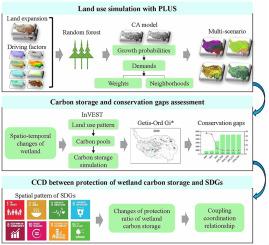当前位置:
X-MOL 学术
›
J. Clean. Prod.
›
论文详情
Our official English website, www.x-mol.net, welcomes your
feedback! (Note: you will need to create a separate account there.)
Coupling coordination between carbon storage protection in alpine wetlands and SDGs: A case study of the Qinghai-Tibet Plateau, China
Journal of Cleaner Production ( IF 9.7 ) Pub Date : 2024-11-19 , DOI: 10.1016/j.jclepro.2024.144260 Yuanxin Liu, Mingyue Zhao
Journal of Cleaner Production ( IF 9.7 ) Pub Date : 2024-11-19 , DOI: 10.1016/j.jclepro.2024.144260 Yuanxin Liu, Mingyue Zhao

|
As an important ecosystem of the planet, wetlands play a pivotal role in carbon storage. For alpine regions, safeguarding wetland carbon storage (WCS) has become an integral aspect of sustainable development. To explore the correlation between WCS and sustainable development, we predicted wetland patterns and WCS on the Qinghai-Tibet Plateau (QTP) for 2030 under four scenarios. Utilizing the spatial boundaries of protected areas (PAs), we evaluated current and future changes in the representation and effectiveness of WCS protection. Furthermore, a coupling coordination degree (CCD) model was used to identify the relationship between WCS protection and Sustainable Development Goals (SDGs). The results showed that lakes and reservoirs/ ponds were the largest and smallest wetland types on the QTP, respectively, and both displayed an increasing trend from 2000 to 2020, while other wetland types mostly exhibited an opposite trend. Scenario analysis revealed the largest increase in river area compared to 2020 under the comprehensive development scenario (CDS), reaching 6.88%. Across all scenarios, lakes would increase by approximately 6%, primarily due to distance to water and population density. The economic development scenario (EDS) experienced the greatest reduction in swamps. Under these four scenarios, compared to 2020, WCS hotspots displayed varying degrees of decline, with the ecological conservation scenario (ECS) experiencing the most significant reduction (4.2%) and the EDS experiencing the least reduction (0.14%). Only swamps and rivers conservation representation can be improved in 2030. For WCS outside PAs, the most significant enhancement was achieved under ECS for all wetlands except rivers. 6 classes of seriously, moderate, slight incoordination and barely, moderate, high coordination areas were detected based on the CCD analysis. Among the above zones, over 65% of prefecture-level municipalities on the QTP exhibited better than barely coordination levels in 2010, and by 2020, the figure had exceeded 69%. This study deepens understanding of the relationship between WCS and sustainable development in alpine plateaus, and provides decision-making support for coordinate regional development and wetland conservation.
中文翻译:

高寒湿地碳储量保护与可持续发展目标的耦合协调——以青藏高原为例
湿地作为地球重要的生态系统,在碳储存中起着举足轻重的作用。对于高山地区来说,保护湿地碳储存 (WCS) 已成为可持续发展不可或缺的一个方面。为探讨 WCS 与可持续发展之间的相关性,我们在 4 种情景下预测了 2030 年青藏高原 (QTP) 湿地格局和 WCS。利用保护区 (PA) 的空间边界,我们评估了 WCS 保护的表现形式和有效性的当前和未来变化。此外,使用耦合协调度 (CCD) 模型来确定 WCS 保护与可持续发展目标 (SDG) 之间的关系。结果表明:湖泊和水库/池塘分别是 QTP 上最大和最小的湿地类型,且在 2000—2020 年均呈上升趋势,而其他湿地类型大多呈相反趋势。情景分析显示,在综合开发情景 (CDS) 下,河流面积与 2020 年相比增幅最大,达到 6.88%。在所有情景中,湖泊将增加约 6%,主要是由于与水的距离和人口密度。经济发展情景 (EDS) 的沼泽减少幅度最大。在这四种情景下,与 2020 年相比,WCS 热点地区表现出不同程度的下降,其中生态保护情景 (ECS) 的减少最显着 (4.2%),而 EDS 的减少最少 (0.14%)。到 2030 年,只有沼泽和河流保护的表现可以得到改善。对于保护区外的 WCS,在 ECS 下,除河流外的所有湿地都实现了最显著的增强。 基于 CCD 分析检测到 6 类重度、中度、轻度不协调和勉强、中度、高度协调区。在上述区域中,超过 65% 的 QTP 地级市在 2010 年的表现优于勉强协调水平,到 2020 年,这一数字已超过 69%。本研究加深了对 WCS 与高寒高原可持续发展之间关系的理解,为协调区域发展和湿地保护提供决策支持。
更新日期:2024-11-19
中文翻译:

高寒湿地碳储量保护与可持续发展目标的耦合协调——以青藏高原为例
湿地作为地球重要的生态系统,在碳储存中起着举足轻重的作用。对于高山地区来说,保护湿地碳储存 (WCS) 已成为可持续发展不可或缺的一个方面。为探讨 WCS 与可持续发展之间的相关性,我们在 4 种情景下预测了 2030 年青藏高原 (QTP) 湿地格局和 WCS。利用保护区 (PA) 的空间边界,我们评估了 WCS 保护的表现形式和有效性的当前和未来变化。此外,使用耦合协调度 (CCD) 模型来确定 WCS 保护与可持续发展目标 (SDG) 之间的关系。结果表明:湖泊和水库/池塘分别是 QTP 上最大和最小的湿地类型,且在 2000—2020 年均呈上升趋势,而其他湿地类型大多呈相反趋势。情景分析显示,在综合开发情景 (CDS) 下,河流面积与 2020 年相比增幅最大,达到 6.88%。在所有情景中,湖泊将增加约 6%,主要是由于与水的距离和人口密度。经济发展情景 (EDS) 的沼泽减少幅度最大。在这四种情景下,与 2020 年相比,WCS 热点地区表现出不同程度的下降,其中生态保护情景 (ECS) 的减少最显着 (4.2%),而 EDS 的减少最少 (0.14%)。到 2030 年,只有沼泽和河流保护的表现可以得到改善。对于保护区外的 WCS,在 ECS 下,除河流外的所有湿地都实现了最显著的增强。 基于 CCD 分析检测到 6 类重度、中度、轻度不协调和勉强、中度、高度协调区。在上述区域中,超过 65% 的 QTP 地级市在 2010 年的表现优于勉强协调水平,到 2020 年,这一数字已超过 69%。本研究加深了对 WCS 与高寒高原可持续发展之间关系的理解,为协调区域发展和湿地保护提供决策支持。


















































 京公网安备 11010802027423号
京公网安备 11010802027423号